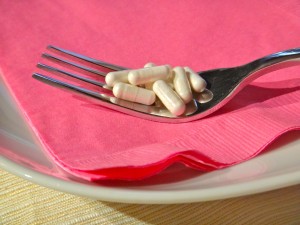Many of us think we are looking after our bones by taking our calcium pills religiously. We drink milk and eat cheese and yogurt, almonds and spinach. Some of us add vitamin D to the mix, hoping that by doing so we’ll avoid osteoporosis.
It’s great that we’re trying to take care of ourselves, but unfortunately we’re missing a most important part of the equation for good bone health and the prevention of osteoporosis and heart disease — Vitamin K2.
The Calcium Paradox
According to Dr. Kate Rhéaume-Bleue in her recent book Vitamin K2 and the Calcium Paradox, vitamin D and calcium are two legs on a three-legged nutritional stool. The third leg that’s essential to bone health is vitamin K2.
Dr. Rhéaume-Bleue describes what she calls the Calcium Paradox, following the 2011 publication of a study showing that women who supplement with calcium are at risk for atherosclerosis. As we know, if we have too little calcium in our bones, we get brittle bones – osteoporosis. However, it’s also been found that if we have too much calcium in our blood vessels, we may get atherosclerosis – hardening of the arteries. It seems like a case of damned if you do and damned if you don’t. “Confusion quickly set in among the millions of health-conscious consumers who heard the news – and among the health care providers who recommend calcium supplements… Is calcium killing us?” asks Dr. Rhéaume-Bleue.
Many of us take vitamin D supplements. Vitamin D is often called the “sunshine vitamin” because we make it in our skin in reaction to exposure to sunlight. Supplementation is often important because we aren’t exposed to enough sunlight or we cover ourselves with sunblock when we are outside. We’ve heard that vitamin D helps us absorb calcium into our bloodstream better, and indeed it does. But the problem is that when calcium gets into the bloodstream it doesn’t necessarily go where it’s needed – to the bones. Some of it may do so, but some of it may stay in the arteries causing cardiovascular problems. Vitamin D has no say in where the calcium will be deposited.
Vitamin K2 Directs Calcium to Bones
Enter vitamin K2. This little-known vitamin actually helps direct calcium to the bones, but it can only do so when vitamin D is present – hence the three-legged stool analogy. Now here’s a little science for you: according to Dr. Rhéaume-Bleue, “K2 activates a protein called osteocalcin, which attracts calcium into bones and teeth, where calcium is needed. K2 activates another protein called matrix gla protein (MGP), which sweeps calcium out of soft tissues like arteries and veins.”
Vitamins D & A
Vitamins D and K2 are both fat-soluble vitamins – unlike the water-soluble vitamins C and all the B’s. Another fat-soluble vitamin is A, and it’s been found that we need both A and D to activate osteocalcin and MGP. Dr. Rhéaume-Bleue says: “…when it comes to the production of K2-dependent proteins, D and A are like a car’s gas pedal and brake pedal respectively. You need both to drive.” We can see then that vitamins D and A together form one of the legs of our bone-health stool.
I should point out that vitamin K2 is not the same as K1, which is responsible for blood clotting. We get K1 from our dark green leafy veggies – kale, chard, and the like. There may be a little influence on bone health, but it is K2 that really holds the key here.
Healthy Diet
It isn’t enough, however, to simply add vitamins A, D, and K2 and calcium to our diets, either through food or supplementation, if we don’t follow a healthy diet overall. Let’s select the best quality food we can. If we eat animal products, let’s choose those that have been raised on the kinds of foods they would naturally eat – grass and other vegetation, not grains. Grain-fed animals lack K2, and there are a whole host of other reasons not to eat grain-fed beef, pork or chicken.
When choosing vegetables and fruits, let’s try to buy organic and in season, so that we get the best possible nutrients from our food. If we eat grains, let’s choose whole grains. We can increase their nutritional potential by soaking or sprouting them before consumption.
And as usual, eat that rainbow array of colourful fruits and vegetables, drink lots of water, and get lots of regular exercise.
Food Sources of K2
So, how can we get vitamin K2 in our diets? As mentioned above, the best sources are from grass-fed cattle – the meat and the milk-products – like beautiful golden butter, not the pale version we usually find – along with fermented cheeses and organ meats. The meat and eggs from pastured hens are good sources of the vitamin. For vegans, it is also available in fermented foods such as sauerkraut, kimchi and daikon ginger, which are high in Vitamin K2. Natto, a fermented soybean from Japan is very high in K2, but apparently somewhat difficult to eat. I haven’t come across it myself, but apparently it has an extreme odour and taste, and takes some getting used to.
Supplementation
We can up our intake of foods with K2, or we can take a good supplement. There are combination supplements out there that have calcium along with vitamins D and K2. Please ask at your local health food store, but be careful NOT to buy vitamin K3, which is synthetic. Also, ensure you get Vitamin K2 in the MK7 form not the MK4 form.
Note: If you are taking a medication you may want to check with your natural health care provider first.
Weight-bearing Exercise for Strong Bones
In addition to a healthy diet, our bones need to work – exercise is key to bone health. We need to get 30 minutes at least three times a week of weight-bearing exercise. This might be walking or running, or practicing yoga – did you know that the standing poses in yoga are considered weight bearing? Swimming and cycling are great activities, but they are not weight bearing, and so not as wonderful for the bones – but keep them up nonetheless, they’re fantastic for strength, flexibility and heart health. If your time is tight, you can split your 30 minutes into two or three sessions during the day. So get off the subway one stop before your usual stop and walk to your destination. Take the stairs up two to four flights rather than take the elevator. Go out after lunch and walk for ten minutes – this will not only benefit you physically, but it will also help clear your mind for the afternoon’s work.
On the negative side, smoking, and drinking excess coffee or alcohol, can leach calcium from our bones, as can soft drinks. Soda is high in phosphates with virtually no calcium, and when phosphate levels are high and calcium levels are low, calcium is pulled out of bones. Consequently, if we want to improve our bone health, we need to address our use of these products.
If you’ve already started including K2 in your diet, we’d love to know what your experience has been. Just go to the comments section below, and let us know how this has worked for you.
Also, if you know of anyone who is concerned about osteoporosis or heart disease please share this article with them and help us spread the word about vitamin K2.
Sources:
Book: Vitamin K2 and the Calcium Paradox, Dr. Kate Rhéaume-Bleue
Book: Encyclopedia of Natural Medicine, Michael Murray & Joseph Pizzorno
“Forgotten for Over 80 Years –
Could this Be the New Vitamin D?” http://products.mercola.com/vitamin-k/
Vitamin K2 & the Calcium Paradox http://www.ancestralizeme.com
Vitamin K and bone health. http://www.ncbi.nlm.nih.gov/pubmed/11684396
Effects of vitamin K on calcium and bone metabolism. http://www.ncbi.nlm.nih.gov/
Nutrition in Bone Health: http://www.jacn.org/content/
How Does Vitamin A Affect My Bones? http://www.niams.nih.gov/Health
Vitamin A and Bone Health: http://www.livestrong.com
What Foods Have Vitamin K2 in Them? http://www.livestrong.com
Japanese Food: Natto http://www.links.net/vita/trip/japan/food/natto/
What is Natto? (A young man tries it for the first time). http://www.youtube.com



